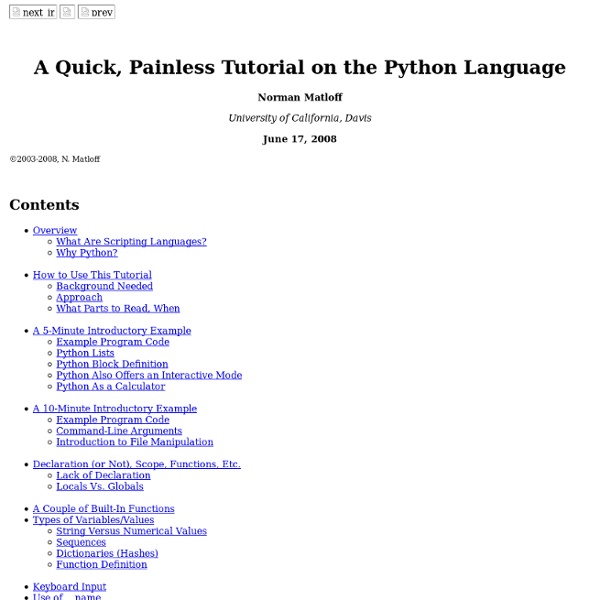Tutorial on the Python Language

http://heather.cs.ucdavis.edu/~matloff/Python/PythonIntro.html
Invent with Python
Chapter 1 Read online: Chapter 1 - Installing Python Videos: Chapter 2
30 game scripts you can write in PHP, Part 1: Creating 10 fundamental scripts
Getting started As both a game master/storyteller and a developer, I frequently find myself writing little utilities and scripts to help me when running, planning, and playing games. Sometimes I need a quick idea.
My Collection of Funny Emails. Send funny emails to your friends!
Why didn’t I think of that? You’ll be uttering those words more than once at these ingenious little tips, tricks and ideas that solve everyday problems... some you never knew you had! Hull strawberries easily using a straw. Rubbing a walnut over scratches in your furniture will disguise dings and scrapes.
Game From Scratch C++ Edition!
Want to create a game using C++ and SFML? This is the perfect place to start! This tutorial series will follow the creation of a simple game in C++ from the very beginning till the end, a micro-version of the overall purpose of this site.
Best Linux Distributions
On this page you will find the best Linux distros for various purposes. We've taken the effort to categorize them and picked only those we believe to be the best ones and which will most likely be useful to you. One of the most popular general-use distributions with one of the largest selections of software. Based on: Debian The most cutting-edge general-use distribution on a 6-month release cycle.
12 Absolutely and Insanely Essential Utilities For Programmers
In every era in recent times there has been one profession that for a short while you could enter without formal training. Autodidacts in the 19th century could read the law without recourse to formal education (see Abe Lincoln). In the early 20th century it was aviation. For a short while in the 1980s and early 1990s, it was computing, thanks to the release of the Apple IIe, the IBM PC and the Mac. Were it not for that Window® of opportunity, I hate to think what would have become of me. (Hey buddy, can you spare a dime?)
TRIZ - A powerful methodology for creative problem-solving - Creativity techniques from MindTools
A Powerful Methodology for Creative Problem Solving How could the idea of these Russian Dolls be applied to retailing? © iStockphoto/BomBeR_irk Projects of all kinds frequently reach a point where as much analysis as possible has been carried out, but the way forward is still unclear. Progress seems blocked, and if the project team is to move forward, it must develop creative solutions to the problems it faces.
Photo Manipulation Tutorials: 50+ Wickedly Creative Tips
Since our last Photoshop tutorial titled: Adobe Photoshop Tutorials: Collection of Amazing Tips And Tricks , we got so much positive feedback that we decided to put together another collection of tutorials concentrating on photo manipulation. In this post, you’ll find everything from How to Create Cityscape Concept Art to Making a Devastating Tidal Wave in Photoshop. Now the hard part will be deciding which of these amazing tutorials you will use in your next creations. Hope you enjoy!
Related:



